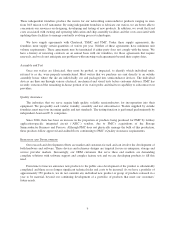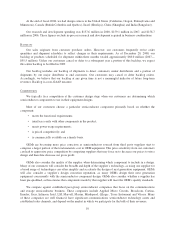Adaptec 2008 Annual Report Download - page 18
Download and view the complete annual report
Please find page 18 of the 2008 Adaptec annual report below. You can navigate through the pages in the report by either clicking on the pages listed below, or by using the keyword search tool below to find specific information within the annual report.problems may also result in claims against us by our customers or others. In addition, these problems may divert
our technical and other resources from other development efforts. Moreover, we would likely lose, or experience
a delay in, market acceptance of the affected product or products, and we could lose credibility with our current
and prospective customers.
Our business may be adversely affected if our customers or suppliers cannot obtain sufficient supplies of
other components needed in their product offerings to meet their production projections and target
quantities.
Some of our products are used by customers in conjunction with a number of other components, such as
transceivers, microcontrollers and digital signal processors. If, for any reason, our customers experience a
shortage of any component, their ability to produce the forecasted quantity of their product offerings may be
affected adversely and our product sales would decline until the shortage is remedied. Such a situation could
harm our operating results, cash flow and financial condition.
We rely on limited sources of wafer fabrication, the loss of which could delay and limit our product
shipments.
We do not own or operate a wafer fabrication facility. Two outside wafer foundries supply more than 95%
of our semiconductor wafer requirements. Our wafer foundry suppliers also make products for other companies
and some make products for themselves, thus we may not have access to adequate capacity or certain process
technologies. We have less control over delivery schedules, manufacturing yields and costs than competitors with
their own fabrication facilities. If the wafer foundries we use are unable or unwilling to manufacture our products
in required volumes, or at specified times, we may have to identify and qualify acceptable additional or
alternative foundries. This qualification process could take six months or longer. We may not find sufficient
capacity quickly enough, if ever, at an acceptable cost, to satisfy our production requirements.
Some companies that supply our customers are similarly dependent on a limited number of suppliers to
produce their products. These other companies’ products may be designed into the same networking equipment
into which our products are designed. Our order levels could be reduced materially if these companies are unable
to access sufficient production capacity to produce in volumes demanded by our customers because our
customers may be forced to slow down or halt production on the equipment into which our products are
designed.
We depend on third parties for assembly and testing of our semiconductor products that could delay and
limit our product shipments.
We depend on third parties in Asia for the assembly and testing of our semiconductor products. In addition,
subcontractors in Asia assemble all of our semiconductor products into a variety of packages. Raw material
shortages, political and social instability, assembly and testing house service disruptions, currency fluctuations,
or other circumstances in the region could force us to seek additional or alternative sources of supply, assembly
or testing. This could lead to supply constraints or product delivery delays that, in turn, may result in the loss of
revenues. At times, capacity in the assembly industry has become scarce and lead times have lengthened. This
may become more severe, which could in turn adversely affect our revenues. We have less control over delivery
schedules, assembly processes, testing processes, quality assurances, raw material supplies, and costs than
competitors that do not outsource these tasks.
Due to the amount of time that it usually takes us to qualify assemblers and testers, we could experience
significant delays in product shipments if we are required to find alternative assemblers or testers for our
components. Any problems that we may encounter with the delivery, quality or cost of our products could
damage our customer relationships and materially and adversely affect our results of operations. We are
continuing to develop relationships with additional third-party subcontractors to assemble and test our
products. However, even if we use these new subcontractors, we will continue to be subject to all of the risks
described above.
18
























